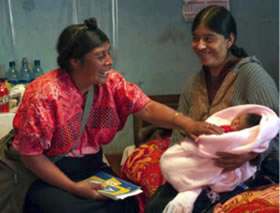UNFPA: Good Practice Example 2
Interculturality in Health, and Opportunity for Equity: The Case of Otavalo, Ecuador

In 1984, the Jambi Huasi Health House was founded in Otavalo, Ecuador. The initiative aimed to integrate indigenous and western health systems by utilizing the strengths of both and adapting them to the specific needs of indigenous peoples. The model has since served as a starting point for progressing from a non-governmental initiative to an instrumental programme, bringing an intercultural reproductive health approach to a public hospital, the San Luis Hospital of Otavalo.
Within this framework and with continued support from UNFPA, work began on the creation of an intercultural model for reproductive health care in the hospital. This model is proving to have positive impact on the empowerment of indigenous women, acting upon cultural and gender determinants and increasing effective use of medical services. The contraceptive prevalence rate has increased and both the infant and maternal mortality rates have fallen.
Aspects of the intercultural reproductive health model that are contributing to increased access to the hospital's services include:
- Utilizing a people-centered approach, in which the beneficiaries have ownership of the initiative.
- Reinforcing the cultural identity of the community, including creating culturally acceptable delivery rooms, providing food according to the patient's customs, allowing the use of traditional plant infusions and teaching health providers the Kichwa language.
- Accommodating the participation of traditional birth attendants in the hospital during delivery and redefining their role as key cultural brokers between worldviews.
- Establishing a community network for the reduction of maternal mortality.
- Creating a maternity home where indigenous women can go a few days prior to their delivery.
- Making it possible for husbands, family members and traditional birth attendants to be present during labour.
- Dis-agggregating birth registry data by ethnicity.
This new model of reproductive health care is expanding to other indigenous and rural communities through the creation of programmes led by traditional birth attendants or midwives. In coordination with the hospital, birth attendants and midwives map all pregnant women in order to better monitor their pregnancies and provide them with information on possible obstetric risks.
Key factors that contributed to the successful integration of an intercultural approach at San Luis Hospital were the municipality's support under the leadership of an indigenous mayor and ongoing policy revision at the provincial and regional levels of the Ministry of Health.